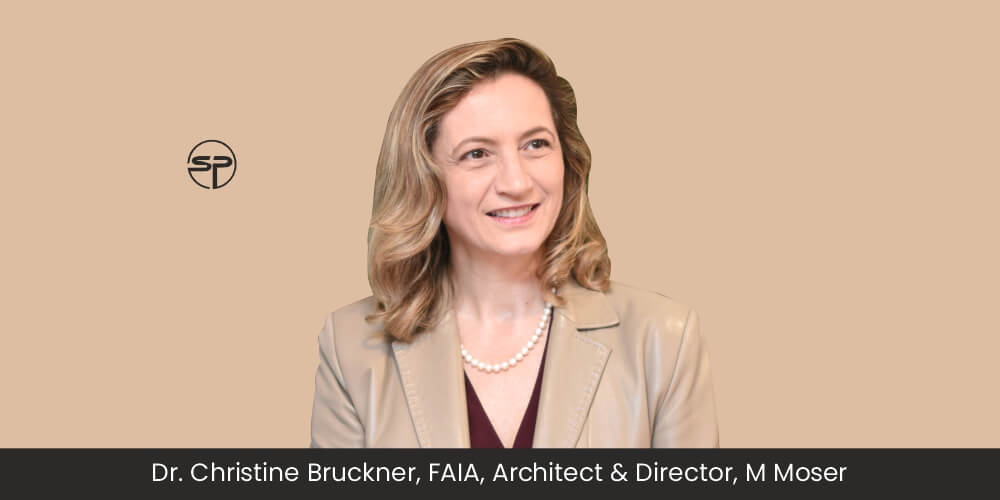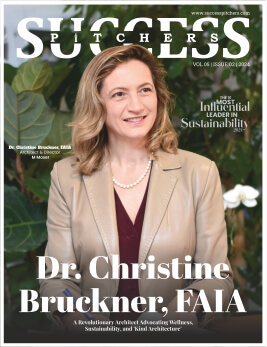Dr. Christine Bruckner, FAIA: A Revolutionary Architect Advocating Wellness, Sustainability, and ‘Kind Architecture’
The 10 Most Influential Leader in Sustainability, 2024

An esteemed architect and Director at M Moser, Dr. Christine Bruckner, FAIA is a dedicated advocate for best practices, sustainability, and wellness in design. With a rich background in urban integration, revitalization, and design excellence, she plays a pivotal role in shaping the built environment at various scales. As a LEED AP, BEAM professional, and early adopter of the International WELL Building Institute, Dr. Bruckner leads M Moser’s global initiatives in WELL integrative design solutions.
Dr. Bruckner’s design philosophy centers around creating sanctuaries for the human spirit—spaces that are adaptable, sustainable, and nurturing. With a focus on client and community engagement, Dr. Bruckner’s champions deep-dive investigations, coordination, and sustainable best practices. She believes in fostering spaces where every individual feels welcomed, valued, and supported in all aspects of their being, forging a mutual commitment between the planet and its inhabitants.
Dr. Bruckner’s paradigm of ‘kind architecture’ seamlessly blends best practices, sustainability, and wellness. Rooted in creating relevant spaces for all people, this approach prioritizes the spiritual, mental, and emotional well-being of users. It embodies principles such as optimizing design, minimizing waste, maximizing integration with nature, and making thoughtful choices in materials and techniques.
For Dr. Bruckner, sustainability is not merely an aspect; it is the essence of her design philosophy. To transform intangible concepts into tangible spaces, she leverages light to define architectural experiences, works with proportions, sequence, texture, materiality, and multi-sensory integration. Her designs incorporate elements inspired by nature, fostering a sense of ‘places of belonging.’
In her commitment to creating spaces supportive of long-term mental and emotional health, Dr. Bruckner utilizes sustainable practices that resonate in every aspect of her architectural vision. Through her work, she goes beyond structures and spaces, creating environments that nourish the human spirit and contribute positively to the well-being of individuals and the planet.
Architectural Heritage
Dr. Bruckner’s upbringing was shaped by the impactful work of her parents in architecture, where her mother’s understanding of human needs and her father’s commitment to innovative, healthy spaces influenced her perspective. Observing her father’s meticulous approach to inspecting and renovating houses, regardless of context, instilled in her the belief that exceptional architecture should be accessible to all, emphasizing creativity and resourcefulness.
In her career, these principles serve as a compass, guiding Dr. Bruckner to prioritize designs that are not only aesthetically pleasing but also deeply humane and inclusive. This commitment results in innovative solutions prioritizing people’s well-being, reflecting a core driving force in her approach to architecture.
Through a dedication to these values and a continuous pursuit of learning and adaptation, Dr. Bruckner has curated functional, beautiful spaces that nurture and empower those who inhabit them. This responsibility is taken seriously, honoring her parents’ legacy and a shared belief in the transformative power of architecture to positively impact lives and communities.
An Inclusive Design Approach
As a LEED AP and HK BEAM professional, Dr. Bruckner emphasizes the importance of investigating design briefs through a multi-faceted lens of certifications at the beginning of her projects. This approach helps identify all requirements from the outset, considering them not as extras but as fundamental aspects of the process. Her core values align with the work at M Moser, emphasizing the interconnected privilege of caring for the planet and its people.
Valuing wellness as a pivotal aspect of her practice, Dr. Bruckner recognizes that a well-planned space can be both preventative and elevating, enhancing health, reducing stress, and supporting concentration. Design considerations, such as adjustability of sound levels and flexibility in access and movement options, address various aspects of the human experience, covering a wide range of needs. Her goal is to shape spaces that minimize obstacles, fostering a natural sense of inclusion and confidence for every individual.
Dr. Bruckner welcomes opportunities to serve and mentor in a community that supports ongoing team growth. Drawing from her unstoppable curiosity and the models set by her parents, she fosters a love of continuous learning and creates opportunities to keep teams updated with research and new methods. This collective knowledge is then applied to the design of inclusive spaces for all.
Elevating Human Well-being
In her leadership role, Dr. Bruckner finds fulfillment in incorporating wellness principles into architectural projects. She believes that architectural design excellence inherently contributes to human physical, mental, and spiritual well-being. This commitment to wellness is embedded in every stage of a project, from initial design concepts to material selection, interior layouts, and construction processes. The focus includes prioritizing natural light, ensuring air quality, integrating biophilia, designing for physical movement and mental well-being, and carefully considering the impact of each design decision.
The process begins with a thorough exploration of client needs and an assessment of potential wellness goals for the project. This approach yields tangible benefits, including improved health, reduced stress, enhanced mental sharpness, and increased physical vitality. One notable success involved a ‘wellness’ workplace designed by Dr. Bruckner, where the positive changes in employee engagement and well-being were evident to the CEO, resulting in increased morale, productivity, and exceptional retention rates.
By prioritizing human well-being in design, spaces are created that not only meet functional needs but also foster a healthy, vibrant, and creative atmosphere. This holistic approach, addressing physical, mental, and emotional well-being, contributes to a fulfilled and engaged workforce community. Incorporating wellness principles into architectural projects is a dedicated commitment to enhancing the human experience.
Advocating for Simple, Elegant, and Sustainable Design Solutions
Dr. Bruckner acknowledges difficulties in conveying that sustainable solutions can be simple, cost-neutral, and not overly complex. To address this, she emphasizes demonstrating that incorporating best practices from the beginning can significantly enhance the final result without direct cost correlation if done thoughtfully. Additionally, dispelling the misconception that sustainable, accessible design is opposed to sophistication is a priority. Dr. Bruckner aims to showcase through implementation that a sustainable design framework can result in graceful, harmonious, and elegant designs.
Material availability poses another challenge, tackled by creating robust supply chains and vetting protocols. Positive design specifications contribute to making sustainable choices more accessible, setting new norms and precedents. This approach aims to make sustainable sourcing equitable, affordable, and widely available, challenging existing value propositions and paradigms. Dr. Bruckner recognizes the importance of unrelenting efforts to shift the perception of sustainability and accessibility in design.
Stakeholder Engagement
Encouraging deep-dive investigations and ensuring alignment with the values and needs of all stakeholders is a complex process requiring empathy, active listening, and a collaborative mindset, according to Dr. Bruckner. The process commences with comprehensive stakeholder engagement, prioritizing open dialogues through workshops, interviews, and surveys to gather a diverse range of perspectives. This aids in clarifying explicit needs, implicit expectations, and cultural nuances of those involved.
Dr. Bruckner believes that facilitating inclusive and interactive collaborative workshops allows stakeholders to voice their thoughts and concerns, fostering a comprehensive understanding of the community’s needs and expectations. Continuous feedback methodologies ensure all voices and nuances are considered throughout the project shaping process. Additionally, incorporating 3D computer models, virtual reality, and AR tours aids stakeholders in envisioning the project and provides ongoing feedback.
Coordination of diverse expertise is deemed crucial. Bringing professionals from various disciplines together ensures a holistic consideration of the design from multiple perspectives. This interdisciplinary approach facilitates solutions aligned with environmental, social, and wellness goals, resulting in higher satisfaction and success in intent, implementation, and user ownership.
Innovative Design Philosophy
In the dynamic field of architecture, staying abreast of technological advancements and innovative design practices is paramount. Dr. Bruckner’s approach to this challenge centers on a dedicated commitment to research and development, with a specific focus on sound, light, tactility, sequence, and other innovative practices.
Dr. Bruckner consistently poses questions about what more can be achieved in a space, how it can serve more people, and invests significant time and resources in staying updated on the latest technological advancements and design trends. This involves reviewing academic and industry literature, actively participating in professional forums, conferences, and leading workshops where cutting-edge ideas are introduced.
Within M Moser, a key aspect of their research approach is the ‘Living Lab’ Offices, serving as testing grounds for new concepts and technologies. By implementing and monitoring the latest design innovations in their own spaces, they gain firsthand experience, allowing for the refinement and adaptation of new ideas in real-world settings. This practical research approach ensures that the solutions proposed to clients are both innovative and practical.
A crucial element of Dr. Bruckner’s methodology is the culture of continuous learning, involving formal training, internal workshop sessions, and fostering a culture of knowledge-sharing. By creating an environment where learning is valued and shared, the entire team stays abreast of the latest developments in the field.
Technological Advancements Transforming Architectural Design
Dr. Bruckner recognizes the transformative impact of technological advancements, particularly virtual design tools, as game-changers in the field of architecture. Building Information Modeling (BIM) has been augmented with Virtual Reality (VR) and Augmented Reality (AR), revolutionizing the visualization and refinement of designs. This integration allows both professionals and clients to immerse themselves in spaces before construction, resulting in more accurate and client-focused outcomes.
One notable application is the visualization of factors like daylight impact, sonic environment, and air quality health through computer modeling technologies before construction. This advanced visualization enables optimization and informed decision-making about environmental impacts, contributing to the creation of more responsible and innovative architectural solutions.
Pushing Boundaries with Innovative, Inclusive, and Sustainable Design
Dr. Bruckner envisions that M Moser’s work will consistently push the boundaries, creating innovative and inclusive spaces that set new standards for design excellence in the long term. The overarching goal is to empower individuals and uplift communities through projects, while remaining mindful of environmental and social responsibilities. To achieve this, there is a commitment to reinforcing dedication to sustainable and human-centric design.
The approach is rooted in continuous learning and adaptation, utilizing new technologies and sustainable practices to reduce environmental impact and enhance human comfort and productivity. M Moser sees itself as part of a larger community of designers, architects, and citizens, all sharing the common goal of creating living and working spaces that improve the health, sustainability, and equity of society.
In every project, M Moser listens, learns, and applies insights to create spaces that consider both people and the planet. The overarching vision is to be a conscientious and respectful participant in the global architectural scene, always mindful of the influence on both the environment and the communities they work with.
Website: mmoser.com










